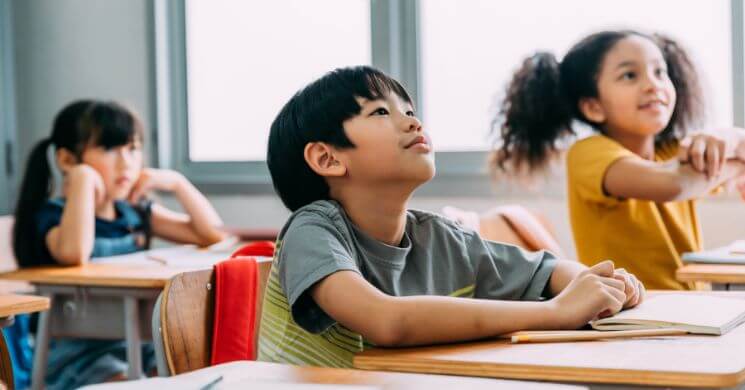“In the midst of movement and chaos, keep stillness inside of you.” – Deepak Chopra
Easier said than done, Deepak.
The world moves quickly, and we forget to live in the moment. This idea of living in the moment is foreign to children who operate at breakneck speed. It’s our job to teach them how to mentally and emotionally slow down and recognize the HERE and NOW.
What is Mindfulness?
Mindfulness may seem trendy; we’re suddenly seeing the concept everywhere. At its core, mindfulness is a state of active and non-judgmental awareness of the present moment. It involves intentionally paying attention to one’s thoughts, emotions, bodily sensations, and the surrounding environment without getting caught up in judgments or clinging to past or future events.
On the other hand, anxiety is also a focus on one’s thoughts, emotions, and bodily sensations, but it lacks the non-judgment and peace that come with mindfulness and positive attention.
It dwells on the negative.
How do we shift from the positive to the negative? And how do we nurture this shift within our kids?
Encouraging Mindfulness in Children
1. Introduce the Concept: Start by explaining to your child what mindfulness is in simple and age-appropriate language. Let her know that it’s about paying attention to the present moment with curiosity and kindness. Phrases like, “look for the good,” are accessible at most ages. Simply asking, “How do you feel about that?”
2. Be a Role Model: Children learn by observing their parents or caregivers, so practice mindfulness and let your child see you engaging in mindful behaviors. She is more likely to be motivated to practice if she sees you valuing and prioritizing it. This role-play can only be beneficial for you both.
3. Practice Together: Engage in mindfulness exercises together as a family. This can include short, guided meditations, deep breathing exercises, or mindful activities such as eating a snack or going for a nature walk. Make it a regular and enjoyable practice that you do together.
4. Keep it Short and Simple: Children may have shorter attention spans, so start with shorter, easy-to-understand practices and activities. Gradually increase the duration as their interest and ability to focus improve.
5. Make it Fun and Creative: Find ways to make mindfulness engaging and enjoyable for your child. Use props, such as a mindfulness jar or soft toys, to demonstrate concepts like calmness and focus. Explore mindfulness through art, storytelling, or incorporating movements, such as yoga or dancing.
5. Use Mindfulness Apps or Resources: Oh, the wonderful world wide web. There are several apps and resources available specifically designed for children. These often include guided meditations, stories, and interactive exercises that can make mindfulness more accessible and engaging for your child.
6. Be Patient and Supportive: Remember that building a mindfulness practice takes time and consistency. Be patient with your child and avoid placing pressure or expectations on her. Encourage her efforts, celebrate small successes, and provide gentle reminders when she forgets to practice.
7. Normalize Emotions: Teach your child that mindfulness can help her notice and accept her emotions, including anxiety, without judgment. Let her know that it’s okay to feel different emotions and that mindfulness can provide tools to navigate and manage them.
3 Kid Friendly Mindfulness and Meditation Activities for Children
Here are 3 examples of easily understandable activities parents and children can do together to cultivate mindfulness and reduce anxiety:
1. Mindful Breathing: Sit comfortably with your child in a quiet space. Encourage him to close his eyes or softly focus on a fixed point. Guide him to take slow, deep breaths, paying attention to the sensation of the breath entering and leaving his body. Encourage him to notice any thoughts or physical sensations that arise without judgment and gently bring his attention back to the breath. Practice this for a few minutes each day. Over time, mindful breathing can help your child become more aware of his body’s responses to stress and promote a sense of calm.
2. Body Scan: Lie down or sit comfortably with your child. Guide her through a body scan exercise by asking her to focus her attention on different parts of her body, starting from the top of her head and moving down to her toes. Encourage her to notice any areas of tension or discomfort and to relax those parts of the body as she becomes aware of them. This activity will help your child develop body awareness, release physical tension, and bring a sense of calm to her entire body.
3. Gratitude Journal: Create a gratitude journal with your child. Each day, sit together and write down three things you and your child are grateful for. Encourage your child to be specific and express why he is grateful for each item or experience. This activity helps shift focus toward positive aspects of life and cultivates a sense of appreciation. Over time, it can help your child reframe his perspective, reduce anxiety, and promote a more positive mindset.
Remember, each child is unique, and it’s important to tailor the approach to their individual needs and interests. Keep the practice light, enjoyable, and flexible, allowing your child to find his own connection to mindfulness.
Give Your Child The Tools They Need
Navigating through the challenges of a child’s anxiety can be tough, but it doesn’t have to be. Learn how our customized education plan can make a difference. Schedule an open house tour at https://broachschool.com/schedule-a-tour/.


